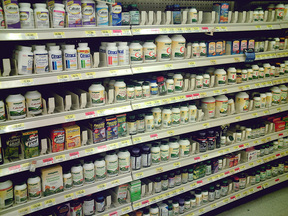 Part 3/Supplements How do I choose the right brand of supplements? The first thing to understand is that there are three categories of nutritional supplements: Feed Grade, Food Grade, and Pharmaceutical Grade. Although the FDA does not regulate or oversee the production or sale of nutritional supplements, it has created guidelines by which to evaluate their quality, known as GMP (Good Manufacturing Practice) regulations. The National Science Foundation (NSF) has added recommendations to GMP which has led to the creation in the United States of a set of standards which can be used to categorize supplements: Feed Grade supplements meet the scientific standards for safe animal consumption. Food Grade supplements meet the scientific standards for safe human consumption. Pharmaceutical Grade supplements meet the same scientific standards for efficacy, purity, safety, and reliability as drugs. Pharmaceutical Grade (PG) supplements must be a minimum of 99% pure, contain no binders, fillers, excipients, dyes, flavor enhancers, or undisclosed substances. They are standardized such that each pill, capsule, or metered dose of the substance contains the correct amount(s) of active ingredient(s) as is indicated on the label. In addition, PG supplements are formulated to yield a higher degree of bioavailability (the ability of the body to absorb and utilize the substance) than are Food Grade (FG) supplements. In this way, smaller doses of PG supplements may in fact carry more benefit than higher doses of FG supplements commonly carried by supermarkets and pharmacies in the United States. Most PG supplements are available only through doctors, although recently some manufacturers have begun offering these products in specialty retail stores and online. Because PG supplements are a superior product, they do generally cost more than FG. Depending upon the supplement, the grade can make a critical difference in terms of not just efficacy but safety as well. For example, Omega-3 fatty acids (fish oils) are a very important and popular supplement which should only be consumed if it is PG (more about this later). In other cases, however, FG, while not as pure, potent, or reliable as PG, may be good enough and worth buying for people on a tight budget. Vitamin C is an example of a popular supplement for which a FG version would suffice for most people (again, more about this later). When buying FG supplements, a good rule of thumb is to purchase well-known, ‘big’ brands, such as Centrum, or Life Extension. Another good idea is to visit your local vitamin shop and speak to the salesperson in charge. He or she should be able to guide you toward the best quality FG products on the market. If you decide to purchase PG supplements, speak to your doctor. Here at our chiropractic office, we sell Pure Encapsulations supplements at prices which compete with–and in some cases beat–many of the Food Grade products found in retail stores and supermarkets. Check out the products we offer here: http://www.purecapspro.com/drberkoff Author: Dr. Gregory Berkoff
1 Comment
Part 2 of the supplements series
No. Well, yes. Okay, read on... Everything bodies need nutritionally to maintain adequate health and function can be provided through a proper diet. Protein, healthy fats, fiber, vitamins, anti-oxidants, and minerals are abundant in nature, and without too much effort or expense, adequate nutrition in the United States should be the rule. Sadly, this is not the case. One reason is that our lifestyles have changed in such a way that convenience is often the deciding factor in choosing what, when, and how we eat. Fresh, nutritious foods are generally less convenient and more costly than packaged, processed foods. In 1970, Americans spent about $6 billion on fast food; by 2000, that number grew to more than $110 billion! Americans today spend more money on fast food than they do on higher education, computers, or cars. The problem, as we all know, is that fast food tends to be high in bad stuff like preservatives, additives, flavor enhancers, saturated and trans-fats, sugar, starchy carbohydrates, extreme levels of sodium, and of course calories, while also being notoriously low in the good stuff we need like vitamins, minerals, lean protein, fiber, and healthy fat. It is recommended that adults eat at least 6 servings of fresh fruits and vegetables per day. But do you? On average, Americans eat less than one and a-half servings of fruits and veggies per day with nearly 20% of adults reporting consuming less than one whole serving of fresh fruit per week! Statistics show that nearly half of young adults regularly skip breakfast and about one quarter regularly skip lunch. Skipping meals leads to habitual snacking, and more than half of all Americans eat packaged, processed snack food on a daily basis. Like other fast foods, most snack foods are high in bad stuff and low in the good stuff. Perhaps most alarming is the fact that so-called ‘healthy snacks,’ like granola, energy bars, trail mix, fruit roll-ups, raisins, and ‘power bars,’ are often not much better for you than chips or candy. Marketed as ‘natural’ and ‘health’ foods, these items are generally loaded with sugar and processed with chemicals to keep them from spoiling or clumping. To your body there is little difference between trail mix and a candy bar. Fast food, junk-food snacking, caffeine-laden ‘energy drinks,’ missed meals, and late night eating are all part of our fast-paced American lifestyle and the result is that most Americans are not getting all the nutrients they need from their diet. As if this weren’t enough reason to consider nutritional supplementation, fruits and vegetables are simply not as packed with nutrients as they once were. Many health professionals now believe that the recommendation of 6 servings/day of fresh fruits and/or veggies should be increased to 6-8 servings. Commercial farming practices have led to soil depletion, breeding of crops (and animals) for size and appearance over nutritional value, and the picking of produce long before many of the most important healthful nutrients have been adequately absorbed or developed. In 2004, The Journal of the American College of Nutrition published startling findings which showed that the nutritional value of fruits and vegetables have been steadily declining since 1950.(2) Produce, though bigger and better looking than ever, has less taste and lower nutritional value than it once did. Broccoli in 2004 contained about half the calcium it did in 1950, and that’s just the tip of the nutrient-drain iceberg. Levels of calcium, riboflavin, vitamin C, iron, potassium, and protein in virtually all commercially grown produce have significantly declined, and this report covered only a few common nutrients; potential declines in lesser-known but highly important nutrients like lycopene and zeaxanthin are unknown. The growth of organic farming and the increasing popularity of Farmers Markets which offer foods of higher nutritional value, grown in more nutrient dense soil, and typically allowed more time to ripen on the vine or tree, represent our best attempt to reverse the nutrient drain. Organic and sustainably farmed foods could potentially eliminate the need for supplementation to achieve adequate nutrition. But are you eating 6-8 servings of organic produce each day? And what do we have to do to get better than just “adequate” nutrition? Author: Dr. Gregory Berkoff |
AuthorArchives
August 2021
Categories
All
|



 RSS Feed
RSS Feed